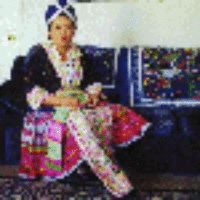
Chamy Thor
From time beyond memory or record an intricate textile art clothed Hmong people. A distinguishing technique is elaborate reverse applique carefully cut into a top layer of cloth sewn back to reveal the layers below. Symmetrical designs have names such as elephant foot, spider web, and snail shell. They identify the wearer’s region and serve as a bond between family members. New clothes are worn on New Years. Special clothes are put on the deceased so that the family will recognize one another in the spirit world.
Chamy Thor’s mother began teaching her cross-stitch when she was six and reverse applique when she was eight. By the time she was 21, she was an expert in basic pa dao. War ravaged the Hmong homeland in Laos, but the dispersed people survived and took their culture with them. In refugee camps in Thailand pa dao attracted the world. Chamy Thor was among the first Hmong women to embroider the intricate traditional patterns and to create narrative story clothes for export. In the United States many Hmong women do not find the time to sew pa dao. Chamy Thor teaches others and is an example in her determination to keep sewing. Because of her efforts some Hmong women of the generation growing up in the United States desire to learn pa dao.
Camy Thos served as a master artist in ACTA’s Apprenticeship Program in 2000 with apprentice, her niece My Chue Lor.
